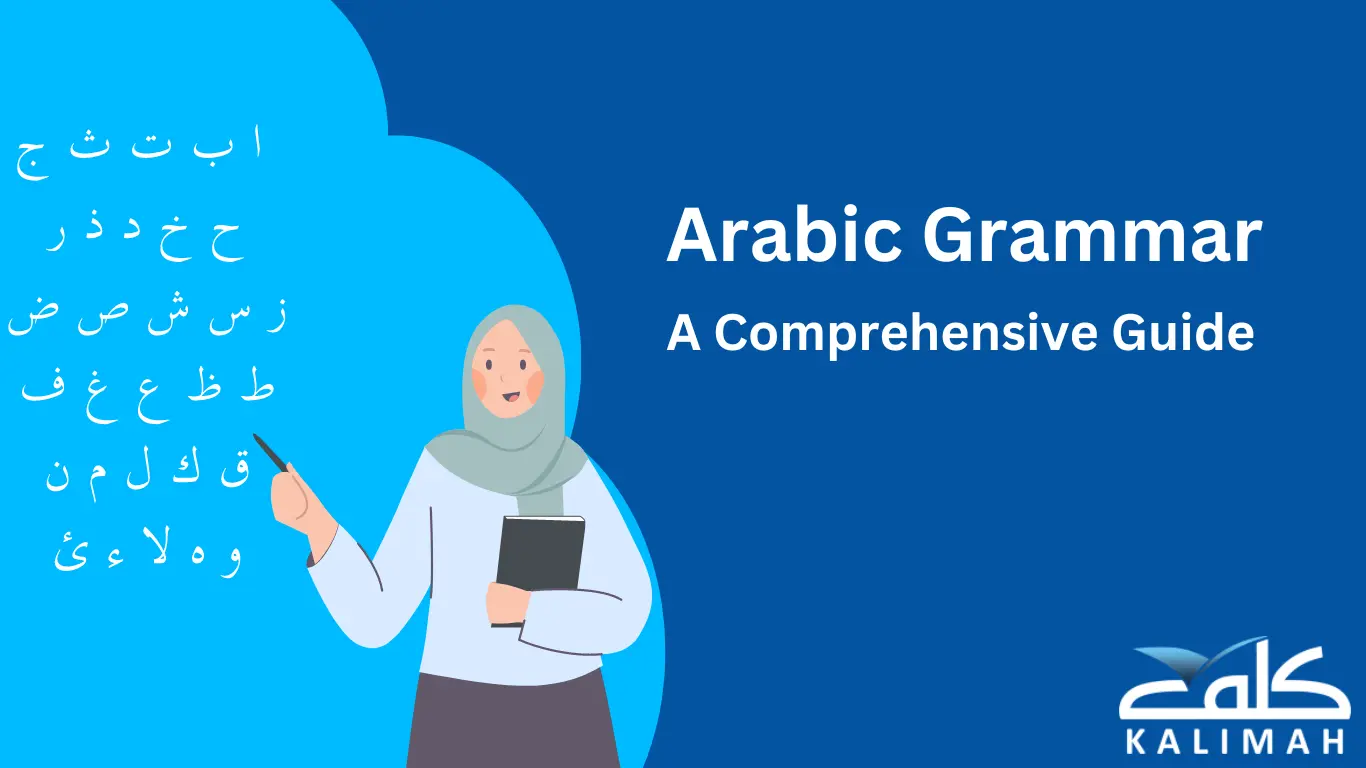Arabic is one of the Semitic languages. The Arabic verbs are derived from a set of three consonants, known as base letters. The process of deriving verbs from these base letters is called Arabic verb conjugation.
In this article, we will explore the methods of Arabic verb conjugation in the past, present and imperative forms, in addition to the differences between English and Arabic verb conjugation, and some helpful resources to master verb conjugation.
What is verb Conjugation in Arabic?
Through the Arabic verb conjugation process, Arabic verbs are inflected to indicate tense, plurality, person, and gender.
Additionally, each conjugated form has a unique meaning that is derived from the base letters. With knowledge of these rules and their proper memorization, you can master Arabic verb conjugation.
In Modern Standard Arabic, verbs are categorized based on three main tenses, and the past tense of the root verb is used to make the necessary changes in each form.
How to conjugate verbs in Arabic
The Arabic language features a triliteral verb system, where most verbs are based on the roots of three consonants, known as radicals.
The Arabic verb has only three forms, namely the perfect (madi), the imperfect (mudare), and the imperative (amr).
The perfect tense, also known as past perfect tense, denotes an action that was completed and finished in the past.
On the other hand, the imperfect tense refers to both the present and the future time for an incomplete action that is either in progress or to be completed in the future.
Lastly, the imperative tense implies an order, desire, wish, or supplication.
To indicate the pattern of a verb, the grammarians use the three consonants of the verb “fa’ala” which means “to do or doing”. In this, the letter ‘ف’ represents the first radical, the third radical ‘ع’ represents the second radical, and ‘ل’ represents the third radical.
Conjugating the Past Tense in Arabic
To form the past tense in Arabic, you start with the root of the verb, which is the singular male form of the verb. Then, you add a suffix depending on who or what the verb is referring to.
For instance, the verb “kataba”, which means “to write” and originates from the root (ك- ت ب), k-t-b, is considered a base verb that follows this pattern. In order to conjugate it in the past tense, you should add the appropriate suffix. See the following table for more details on past tense Arabic verb conjugation.
| Form | Verb in the past | Meaning | Transliteration |
| I | كَتَبتُ | I wrote | katabtu |
| He | كَتَبَ | He wrote | kataba |
| She | كَتَبَتْ | She wrote | katabat |
| You (Masculine) | كَتَبْتَ | you wrote | katabta |
| You (Feminine) | كَتَبْتِ | you wrote | katabti |
| You (Plural) | كَتَبْتُم | you wrote | katabtum |
| We | كَتَبْنَا | we wrote | katabnaa |
| They (Masculine) | كَتَبُوا | they wrote | katabou |
| They (Feminine) | كَتَبْنَ | they wrote | katabna |
Conjugating the Present Tense in Arabic
To conjugate present tense Arabic verbs, the first step is to determine the subject by its number (singular, dual, or plural) and gender (masculine or feminine).
Once the subject has been identified, the appropriate suffixes or prefixes are added to the main verb. For instance, if we consider the root ( ك- ت – ب ), k-t-b meaning “write”, we can observe how it is conjugated in the present tense for various subject pronouns in the following chart.
| Form | Verb in the present | Meaning | Transliteration |
| I | اكْتُب | I write | Aktib |
| He | يَكتُب | He writes | Yaktob |
| She | تَكتُب | She writes | Taktob |
| You (Masculine) | تَكْتُب | You write | Taktob |
| You (Feminine) | تَكتُبِينَ | You write | Taktobeen |
| You (Plural) | تَكْتُبُون | You write | Taktuboon |
| We | نَكْتُب | We write | Naktob |
| They (Masculine) | يَكْتُبُون | They write | Yaktuboon |
| They (Feminine) | يَكْتُبْن | They write | Yaktubn |
Conjugating the Imperative Tense in Arabic
The process of conjugating an imperative Arabic verb involves identifying the subject based on their number (singular, dual, or plural) and gender (masculine or feminine).
Once the subject is defined, we can add the appropriate suffixes or prefixes to the main verb. For example, using the root k-t-b which means “to write”, we can apply this process to form the imperative verb.
| Form | Verb in the Imperative | Meaning | Transliteration |
| I | – | – | – |
| He | – | – | – |
| She | – | – | – |
| You (Masculine) | اُكْتُبْ | write | oktob |
| You (Feminine) | اُكْتُبِي | write | oktoby |
| You (Plural) | اُكْتُبُوا | write | oktobou |
| We | – | – | – |
| They (Masculine) | – | – | – |
| They (Feminine) | – | – | – |
You Might be Interested in: The Arabic Prepositions: From Basics To Nuances
Arabic verb conjugation chart
Due to the abundance of pronouns in Arabic and the way they are attached to verbs, it is necessary to use a table to easily recognize the different conjugations and determine the gender, plurality, and person of the subject performing the verb.
The Arabic verb conjugation table includes information about the performer of the action, indicating whether it is the speaker (1st person), the person being addressed (2nd person), or another individual (3rd person).
Additionally, it indicates the gender of the performer, whether masculine or feminine, as well as the plurality, specifying whether one, two, or more than three individuals are performing the action.
By using an Arabic verb conjugation chart, you can practice using verbs in a variety of contexts and improve your overall proficiency in the language. Below is a collective Arabic verb conjugation chart, demonstrating the proper conjugation of the verb (ك- ت – ب ) in the present, past and imperative forms.
| Arabic Verb Conjugation Chart | |||
| Form | Verb in the past | Verb in the present | Verb in the Imperative |
| I | كَتَبتُ | اكْتُب | – |
| He | كَتَبَ | يَكتُب | – |
| She | كَتَبَتْ | تَكتُب | – |
| You (Masculine) | كَتَبْتَ | تَكْتُب | اكْتُبْ |
| You (Feminine) | كَتَبْتِ | تَكتُبِينَ | اُكْتُبِي |
| You (Plural) | كَتَبْتُم | تَكْتُبُون | اُكْتُبُوا |
| We | كَتَبْنَا | نَكْتُب | – |
| They (Masculine) | كَتَبُوا | يَكْتُبُون | – |
| They (Feminine) | كَتَبْنَ | يَكْتُبْن | – |
What are the differences between English and Arabic verb conjugation?
When a verb is conjugated in English, it is combined with a pronoun, but the two remain separate words. For example, “he slept,” “she slept,” “they slept,” “you slept,” “I slept,” and “we slept.” The verb is not impacted, and the pronoun remains separate. However, in Arabic, the pronoun is attached to the verb, creating a single word.
Arabic has more pronouns than English because it includes a dual form and distinguishes between different genders and groups. For example, Arabic has different pronouns for two males, a group of males, two females, and a group of females.
In English, we use “you” to address all genders and groups, but in Arabic, each pronoun is expressed differently.
Tips and tricks to learn Arabic verb conjugation
Arabic verb conjugation can be a challenging aspect of learning the language, but with practice and a few tips and tricks, it can become easier. Here are some helpful suggestions to keep in mind:
-
Memorize the patterns
Arabic verbs follow certain patterns, and memorizing them can make conjugation easier. It’s important to practice and understand these patterns to conjugate verbs correctly.
-
Understand the root letters
Arabic verbs are formed from three root letters. These letters remain constant throughout the different tenses and moods. Understanding the root letters can help you identify the verb and its meaning.
Learn the rules for each tense: Arabic has several tenses, including past, present, and future. Each tense has its own set of rules for conjugation, so it’s important to study and practice them individually.
-
Download Arabic verb conjugation app
An online Arabic verb conjugator can be a helpful tool to assist you with conjugating Arabic verbs especially if you are still a beginner. One example of these free mobile apps is Reverso Conjugator.
-
Join online Arabic classes
One of the best ways to master Arabic verb conjugation and other Arabic grammar rules is to join an online Arabic class where you can easily learn Arabic at your own pace, with the guidance of a native tutor of your choice.
-
Practice, practice, practice!
The best way to improve your Arabic verb conjugation skills is to practice regularly. Write out conjugations, use flashcards, and practice arabic speaking and writing in context.
Arabic verb conjugation practice exercise
-
Select the pronoun with the matching tense, person, and gender as the verb given:
- (…….) استمعَ إلى المُعَلِّم. ( هي، هو، أنا )
- (…….) يشرَبون . (هو، أنا، هم)
- (……..) ذاكرنا الدَّرْسُ جيدًا. ( أنتما، نحن، هي)
To Sum up!
Learning Arabic verb conjugation, or any other complex topic, solely from an online tutorial is not advisable for beginners. To gain a thorough and in-depth understanding of the subject, you will require live instruction, interactive discussions, and feedback on your progress.
Although this tutorial can be helpful, it should be considered as a supplement to Arabic courses taught by experienced and highly regarded instructors. By combining online resources with expert guidance, you can achieve a comprehensive and meaningful education and ultimately achieve your learning goals.
🌟 Unlock Your Potential in Arabic with Kalimah Center! 🌟
Let Kalimah online Quran and Arabic language academy be your study partner by joining our complete online Arabic course today!
Ready to deepen your connection with the Quran and enhance your understanding of Arabic? Join Kalimah Center today and embark on a transformative journey of learning and growth! Our professional, handpicked Online Arabic and Quran Tutors are dedicated to helping you master these essential skills with ease and expertise.
📚 Explore Our Courses:
Online Arabic Course: Tailored to your level, our comprehensive Arabic program includes 16 teaching levels and 400+ hours of personalized sessions.
Online Arabic Course For Kids: Nurture your child’s love for Arabic with our engaging and structured program, available in 24 levels for primary, intermediate, and secondary stages.
💡 Why Choose Kalimah?
Expert Tutors: Learn from native Arabic speakers and Ijazah-certified teachers who prioritize your progress.
Flexible Learning: Enjoy one-on-one classes, 24/7 access to materials, and interactive exercises for a dynamic learning experience.
Comfortable Environment: Benefit from a supportive and encouraging atmosphere, where mistakes are seen as opportunities for growth.
Proven Success: With over 8,000 students worldwide and glowing testimonials, Kalimah Center is your trusted partner in Arabic and Quran education.
🚀 Start Your Free Trial Today! 🚀
Don’t miss out on this life-changing opportunity to deepen your faith and knowledge. Sign up now for your free trial and take the first step towards becoming a better practicing Muslim with Kalimah Center!
FAQs
Is Arabic Verb Conjugation hard?
Although many non-native speakers consider Arabic verb conjugation more challenging compared to other languages including English because the Arabic verb conjugation table is more extensive, featuring singular, dual, plural, masculine, and feminine categories.
However, the upside is that once you have mastered the table for a single Arabic verb, you’re good to go. While there is a category of verbs called “weak” that may seem irregular, each group of these verbs (such as hollow verbs or defective verbs) follows a predictable pattern, which is simply a slight variation on the basic verb conjugation table.
How many Verb Conjugations are there in Arabic?
Verbs in the Arabic language have three tenses (present, past, and imperative), two voices (active and passive), two genders (masculine and feminine), three persons (first, second, and third), and three numbers (singular, dual, and plural).
There are also six moods in the non-past tense only, and nineteen forms that indicate derivative concepts such as causative, intensive, reciprocal, reflexive, frequentative, and more.
Each form has its own active and passive participle (both adjectives), and one verbal noun.
Are all Arabic Verbs Conjugated the same?
No, in the Arabic language, conjugating verbs depends on many factors which are tense, plurality, gender and person.
















